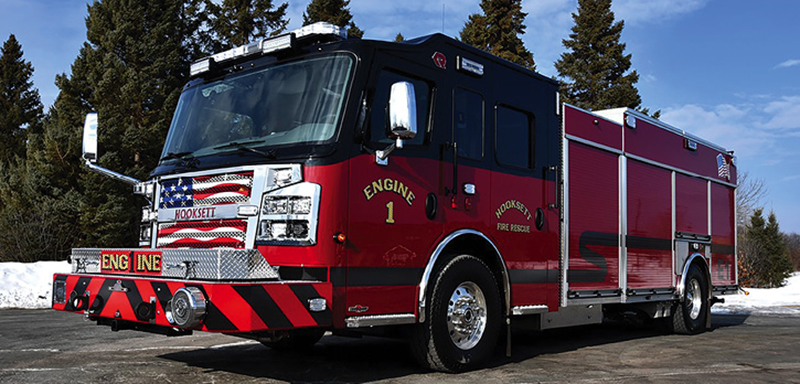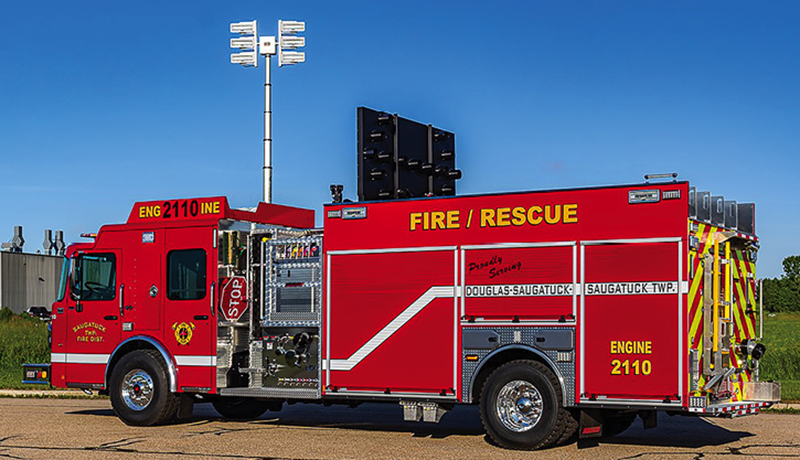The “Bigger is better” trend is alive and well in the fire service. Lots of fire departments are choosing to outfit their new engines with larger fire pumps and bigger water tanks, compared to those being purchased five to 10 years ago.
Apparatus and pump makers acknowledge this trend toward larger water tanks and pumps on engines and say the reasons for such choices are varied.
Mark Brenneman, assistant sales manager for 4 Guys Fire Trucks, says that his company has seen an increase in size in pump capacity and tank gallonage on engines in recent years.
“The lines between pumpers and the pumper-tanker have blurred,” Brenneman observes. “The pump gpm (gallons per minute) on engines have increased significantly, and tank sizes have crept up too. Customers generally know what they want in terms of pump and tank sizes, so it’s up to the manufacturer to get them what they need.”
Brenneman checked the 4 Guys pumper data and found that 1,500-gpm pumps were the most popular size for engines, with the call for smaller 500-gpm to 1,000-gpm pumps sharply reduced. In terms of tanks, 4 Guys didn’t see a corresponding expansion into larger water tanks on engines, although Brenneman notes that may change in the near future. “ I’ve seen pumpers get progressively bigger,” he notes. “There are still smaller engines, but today’s small pumpers are bigger than those of previous days. Pumpers today are the size that tankers were 10 years ago.”
Joe Messmer, president of Summit Fire Apparatus, says his company has been installing Mac1 3,000-gpm module pumps on municipal pumpers, most with 1,000-gallon water tanks, for semi-rural fire departments in the past year. “With the supply chain shortages that are plaguing manufacturers, we looked into alternative pumps and came up with the Mac1,” Messmer says. “Mac1 also has a 1,250-gpm version if the department doesn’t need the higher gallonage. We do the pump end on the 3,000-gpm unit with stainless-steel plumbing so the pump doesn’t take up any more room than a cast iron pump would and also give it a savings in weight.”
Chris Kleinhuizen, systems engineer for Rosenbauer America, says Rosenbauer has been seeing much larger pumps on municipal pumpers. “Many departments are asking for larger pumps but are de-rating them to give them a longer life span,” Kleinhuizen says. “We also are seeing more water tanks sized around 1,000 gallons and up to 1,200 gallons. Staffing is one of the big issues with pump and tank sizes because many departments can’t roll two or three rigs, so they want to do it with one.”
Kleinhuizen notes that Rosenbauer also makes fire pumps and has several series available in the larger sizes. “We have the RN series; then the N110, which produces 2,500 gpm and is used on a lot of aerials; the N130 pump will give 3,500 gpm; and we just proofed the N200 pump that will produce 5,500 gpm,” he says.
Alex Hobday, sales engineer for Spencer Manufacturing Inc., says Spencer has been seeing more large tanks going on pumpers than large pumps. “More water means extending the useful time on the scene,” Hobday observes, “so many departments are turning to pumper-tanker style vehicles, turning two trucks into one.”
Hobday points to a pumper-rescue-tanker that Spencer built for the Angola (IN) Fire Department on a Spartan Metro Star ELFD chassis and cab with a 10-inch raised roof, carrying a Hale QMax-XS 1,500-gpm pump and an 1,800-gallon water tank. “This vehicle was built to allow the department to roll one apparatus on a first-due assignment and not need to rely on a tanker/tender following right behind it,” Hobday points out.
For the Saugatuck Township (MI) Fire District, Spencer built a pumper on a Spartan Metro Star MFD chassis and cab with a 10-inch raised roof, a Hale QMax 2,000-gpm pump, and a 1,600-gallon water tank. “This pumper was built for a department that spends a large amount of time on a busy interstate highway, so they needed to carry a lot of water, rescue tools, and be safe on the road,” Hobday says. “The added water allows the department to put their personnel on the scene and not in an auxiliary tanker/tender. The large-gpm pump also allows the pumper to feed an aerial during a large-scale incident.”

1 Summit Fire Apparatus built this pumper for the Roanoke (IN) Fire Department with a 3,000-gpm MAC1 pump and a 1,000-gallon water tank. (Photo 1 courtesy of Summit Fire Apparatus.)

2 Rosenbauer built this engine for the Hooksett (NH) Fire Department on a Commander chassis with a Hale Qmax 2,000-gpm pump and a 1,000-gallon water tank. (Photo 2 courtesy of Rosenbauer.)

3 The Saugatuck Township (MI) Fire Department had Spencer Manufacturing Inc. build a pumper on a Spartan Metro Star MFD chassis with a Hale QMax 2,000-gpm pump and a 1,600-gallon water tank. (Photo 3 courtesy of Spencer Manufacturing Inc.)

4 Pierce Manufacturing Inc. built this pumper for the Knoxville (TN) Fire Department with a 2,000-gpm pump and an 1,800-gallon water tank on a single rear axle chassis. (Photo 4 courtesy of Pierce Manufacturing Inc.)
Aaron Zak, product specialist lead in fire suppression for Pierce Manufacturing Inc., says Pierce has found that the 1,500-gpm pump size has dominated the market in the past few years. “That size is in about two-thirds of the pumpers we’ve built over the past five years,” Zak says. “Also in that time period, the 2,000-gpm pump has been gaining fast on the 1,250-gpm size.”
In terms of water tank sizes, Zak says that inner city and suburban departments are still choosing water tanks in the 500-gallon to 750-gallon size but that semi-rural and rural departments are going from 750 gallons to up to 1,800 gallons on a single axle pumper.
Jason Nawrocki, sales manager for North American pumps at Waterous, says his company has seen a trend in the fleets of larger cities going to pumps in the 2,000-gpm to 2,250-gpm range. For other departments, Nawrocki notes that the 1,500-gpm pump has been a very stable choice. “When fire departments make a move from the 1,500-gpm pump, they usually skip the 1,750 and go straight to the 2,000-gpm pump,” he says.
Nawrocki points out that the Waterous CMU and CSU pumps can be rated from 1500 gpm to 1,750, 2,000, and 2,250 gpm. “Our CMU is the Centrifugal Multi Ultra pump that has a tungsten carbide impregnated hub on the impeller,” he says, “and the CSU is the Centrifugal Single Ultra with the same impregnated hub.”
Wayne Hable, chief engineer at W.S. Darley & Company, points out the biggest reason for larger pumps on pumpers is that the power plants are able to drive them, so the market has naturally progressed to the larger units. “Fire departments want bigger, faster, and more efficient,” Hable says. “Everyone has been trying to go to 2,000 gpm or 2,250 gpm for the past five years, and FAMA (Fire Apparatus Manufacturers’ Association) data shows bigger pumps becoming more and more prevalent, and it’s because the diesel engines and automatic transmissions are there to power them. The pumps haven’t changed; they’ve always been capable of those bigger ratings.”

5 The Waterous CMUC20 pump is available in 1,500-, 1,750-, 2,000-, and 2,250-gpm sizes. (Photo 5 courtesy of Waterous.)

6 Fort Garry Fire Trucks built this engine for the Sir William Johnson (NY) Volunteer Fire Department on an International chassis with a Hale QMax 1,750-gpm pump and a 3,000-gallon water tank. (Photo 6 courtesy of Fort Garry Fire Trucks.)
While Hable sees the big city municipal markets moving toward 2,000-gpm pumps as standard on their pumpers, he has not seen a corresponding increase in water tanks. “We’re seeing pumpers being changed for dual or multi-purpose, with more crosslays, medical equipment, and rescue equipment, and that means sacrificing tank size,” he observes.
Robert Pike, corporate services manager for Fort Garry Fire Trucks, has the opposite view of Hable’s assessment on water tanks. “The more water a fire department brings to the scene tactically with a small crew means they can deploy larger lines on the fire,” Pike says. “When departments are preconnecting 2-inch hoselines to their engines, they need more water to service those hoselines,” Pike says. “We’re building engines on Freightliner chassis with a 16,000-pound front axle GVWR (gross vehicle weight rating) and a 31,000-pound GVWR rear axle that can carry a 1,250-gallon or 1,500-gallon water tank.”
In terms of pump sizes, Pike says that some departments are sticking with 750-gpm and 1,000-gpm pumps; others are choosing sizes from 1,250 to 1,500 gpm, although those choices require larger diesel engines of 400 horsepower.
Wayde Kirvida, sales engineer for CustomFIRE, notes that for many fire departments, “More water is generally desired. We might see a department looking for a 1,000-gallon tank jump up to a 1,250-gallon tank, but we’ve not seen anyone go from 1,000 to 2,000 gallons.”
ALAN M. PETRILLO is a Tucson, Arizona-based journalist, the author of three novels and five nonfiction books, and a member of the Fire Apparatus & Emergency Equipment Editorial Advisory Board. He served 22 years with the Verdoy (NY) Fire Department, including in the position of chief.

